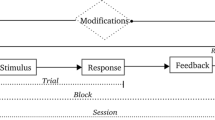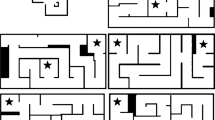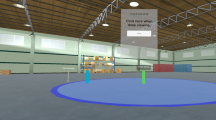Abstract
While many of the existing velocity control techniques are well designed, the techniques are often application-specific, making it difficult to compare their effectiveness. In this paper, we evaluate five known velocity control techniques using the same experimental settings. We compare the techniques based on the assumption that a good travel technique should be easy to learn and easy to use, should cause the user to have few collisions with the VE, should allow the user to complete tasks faster, and should promote better recollection of the environment afterwards. In our experiments, we ask twenty users to use each velocity control technique to navigate through virtual corridors while performing information-gathering tasks. In all cases, the users use pointing to indicate the direction of travel. We then measure the users’ ability to recollect the information they see in the VE, as well as how much time they spend in the VE and how often they collide with the virtual walls. After each test, we use questionnaires to evaluate the ease of learning and ease of use of the velocity control technique, and the users’ sense of presence in the environment. Each of the travel techniques is then evaluated based on the users’ performances in the VE and the results of their questionnaires.








Similar content being viewed by others
References
Barfield W, Zeltzer D, Sheridan T, Slater M (1995) Presence and performance within virtual environments. In: Barfield W, Furness T (eds) Virtual environments and advanced interface design. Oxford University Press, Oxford, pp 473–513
Bowman DA (2001) Testbed evaluation of virtual environment Interaction Techniques. Presence Teleoperators Virtual Environ 10(1):75–95
Bowman DA, Hoges LF (1999) Formalizing the design, evaluation, and application of interaction techniques for immersive virtual environments. J Vis Lang Comput 10(1):37–53
Bowman DA, Koller D, Hodges FL (1997) Travel in immersive virtual environments: an evaluation of viewpoint motion control techniques. In: Proceedings of virtual reality annual international symposium. IEEE Computer Society, Albuquerque, New Mexico, pp 45–52
Bowman DA, Koller D, Hodges LF (1998) A methodology for the evaluation of travel techniques for immersive virtual environments. Springer Virtual Real 3(2):120–131
Bowman DA, Elizabeth TD, Hodges LF, Albert NB (1999) Maintaining spatial orientation during travel in an immersive virtual environment. Presence Teleoperators Virtual Environ 8(6):618–631
Bowman DA, LaViola J, Mine M, Poupyrev I (2001) Advanced topics in 3D user interface design. In: Course Notes, SIGGRAPH 2001
Brederson JD (1999) The I3Stick: an inexpensive, immersive, interaction device. University of Utah Technical Report, UUCS-99-016
Brogan DC, Metoyer RA, Hodgins JK (1998) Dynamically simulated characters in virtual environments. IEEE Comput Graph Appl 15(5):58–69
Couvillion W, Lopez R, Ling J (2001) The pressure mat: a new device for traversing virtual environments using natural motion. In: Proceedings of interservice/industry training simulation and education conference, pp 199–211
Darken R, Siebert JL (1996) Wayfinding strategies and behaviors in large virtual worlds. In: Proceedings of the SIGCHI conference on Human factors in computing systems. Vancouver, pp 142–149
Gabbard JL, Hix D, Swan EJ (1999) User-centered design and evaluation of virtual environments. IEEE Comput Graph Appl 19(6):51–59
Jeong DH, Jeon YH, Kim JK, Sim S, Song CG (2004) Force-based velocity control technique in immersive v.e. In: Proceedings of Graphite 2004, Singapore, pp 237–241
Jeong DH, Lee CS, Jeon GB, Song CG, Babu S, Hodges L (2005) Differentiation on information gathering ability in real and virtual world, In: Proceedings of Pacific Graphics 2005, Macao, pp 157–159
Kamphuis A, Overmars MH (2004) Finding paths for coherent groups using clearance. In: Proceedings of Eurographics/ACM SIGGRAPH symposium on computer animation, Grenoble, France, pp 19–28
Kennedy RS, Lane NE, Berbaum KS, Lilienthal MG (1993) Simulator sickness questionnaire: an enhanced method for quantifying simulator sickness. Int J Aviat Psychol 3(3):203–220
Kessler GD, Bowman DA, Hodges LF (2000) The simple virtual environment library: an extensible framework for building VE applications. Presence Teleoperators Virtual Environ 9(2):187–208
Lee CS, Jeong DH, Kim YR, Park CY, Song CG (2005) Speech based velocity control in immersive v.e. In: Proceedings of Korean Multimedia Society Spring Conference, pp 293–295
Marsh T, Smith S (2001) Guiding user navigation in virtual environments using awareness of virtual off-screen space. In: Proceedings of guiding users through interactive experiences: usability centred design and evaluation of virtual 3D environments. Springer, Heidelberg, pp 149–154
Miller GA (1956) The magical number seven, plus or minus two: some limits on our capacity for processing information. Psychol Rev 63:81–97
Mine M (1995) Virtual environment interaction technique. UNC Chapel Hill, Computer Science Technical Report TR95-018
Paton M, Ware C (1994) Passive force feedback for velocity control. In: Proceedings of CHI94, Boston, pp 255–256
Poupyrev I, Wegorst S, Billinghurst M, Ichikawa T (1997) A framework and testbed for studying manipulation techniques for immersive VR. In: Proceedings of ACM symposium on virtual reality software and technology. Lausanne, pp 21–28
Profitt D, Gilden D (1989) Understanding natural dynamics. J Exp Psychol Hum Percept Perform 15(2):384–393
Slater M, Steed A (2000) A virtual presence counter. Presence Teleoperators Virtual Environ 9(5):413–434
Smith BT, Coiro DJ, Finson R, Betz RR, McCarthy J (2002) Evaluation of force-sensing resistors for gait event detection to trigger electrical stimulation to improve walking in the child with cerebral palsy. IEEE Trans Neural Syst Rehabil Eng 10(1):22–29
Tanawongsuwan R, Bobick A (2004) Modelling the effects of walking speed on appearance-based gait recognition. In: Proceedings of CVPR 2004. Washington DC, pp 783–790
Usoh M, Catena E, Arman S, Slater M (2000) Using presence questionnaires in reality. Presence Teleoperators Virtual Environ 9(5):497–503
Acknowledgments
The authors wish to thank Caroline Ziemkiewicz for her help on constructing and revising the drafts.
Author information
Authors and Affiliations
Corresponding author
Rights and permissions
About this article
Cite this article
Jeong, D.H., Song, C.G., Chang, R. et al. User experimentation: an evaluation of velocity control techniques in immersive virtual environments. Virtual Reality 13, 41–50 (2009). https://doi.org/10.1007/s10055-008-0098-6
Received:
Accepted:
Published:
Issue Date:
DOI: https://doi.org/10.1007/s10055-008-0098-6




